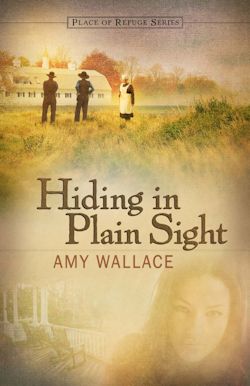|
My
favorite fiction tool and my favorite desserts share a common theme:
they’re chocolate covered. Chocolate-covered strawberries.
Chocolate-covered éclairs. Chocolate-covered Death by Chocolate cake.
Craving some chocolate goodness yet?
In fiction, my favorite
chocolate-covered writing tool is the lie. It’s more bittersweet than a
decadent dessert, but understanding chocolate-covered lies will sweeten
your fiction and provide a satisfying story that draws your readers
deeper into hope and healing.
To help us out here, my newest
character, chocolate-loving police officer Ashley Walters from Hiding
in Plain Sight, will step up and let us analyze her lie. It’s
my hope and prayer that through observing lies at work, you’ll gain a
better understanding of what your character’s lie is and how knowing
her lie will enable you to focus plot and conflict as well as create
even deeper characterization that connects with the heart of readers.
For our purposes, a lie is what
we believe about ourselves—true or not—that drives every one of our
actions and our characters’ actions.
Here are some examples of lies:
I’m unloveable
I’m helpless
I’m worthless
I’m not good enough
I’m stuck
I’m a horrible person
It’s all my fault
I’m a failure
I’m all alone
I’m not enough
Chocolate-covered lies zero in
on what our main character believes is most true about herself, those
emotionally charged phrases your character tells herself.
Let’s take a closer look at
Ashley’s lie: I’m not enough.
On the outside, Ashley is a
tough, street-smart cop who has it all together. She graduated top of
her police academy class and is a favorite with the people she serves
because she goes the extra mile to care about victims of crimes and
makes sure justice is served.
Inside is a different story.
Ashley is broken and hears the tapes in her head play the reasons why.
She never measured up in her parent’s eyes to her perfect, all-American
brother, Eric. When died and she wasn’t able to save him or bring his
killer to justice, she believes her lie as absolute truth. Even so, she
sets out to prove she’s enough, leading her deeper and deeper into
danger.
A different character may
believe the same lie, but give up. She might give in to alcoholism or
failing in school because she believes she’s not enough and doesn’t see
any way to prove otherwise.
The specific attributes and how
your character deals with his or her lie will differ. Just as God
created us to be one-of-a-kind sons and daughters of the King, we
create our characters to be as complex and individual as we are. Tailor
the lies for each character and bring outcomes as varied as your
imagination. But knowing your character’s lie will help you do a number
of vital things with each story you design.
Lies Keep Your
Character’s Journey Focused
Everything that comes against
your character will beat on his lie in one way or another. In real life
we believe certain things about ourselves and those lies drive us
toward perfection in one or more areas, or we give up and don’t bother.
Or we land somewhere between those two extremes. A person who believes
they’re unloveable will interpret every slight, every bad circumstance
as proof of their lie being true.
Ashley grew up with a
protective, loving, superhero of an older brother. Eric was everything
Ashley wanted to be. Eric’s almost perfection beat on what she believed
about herself: that she’ll never be enough.
Early on, Ashley faces at
gunpoint a runaway teenager from the nearby Mennonite community. His
resemblance to Eric breaks through some of her tough walls. Her lie
drives her to help this teen and his family to the point it costs her
everything.
Even Ashley’s relationships are
clouded and endangered the deeper she spirals, the more she tries to
prove she is enough, all the while believing she’ll never be enough.
Lies are powerful motivators …
and destroyers of our, and our characters’, dreams. So when we trace
our characters’ pathways using their lies as a guidepost, we create a
believable and impossible-to-ignore journey that carries with it the
potential to point readers, and ourselves, to the truth and toward
healing.
Lies Enhance Conflict
In fiction, we usually compress
a lot of trials into a short span of time, always increasing the
trouble and danger, both emotional and physical. One way to add depth
to those trials and make them touch readers at a heart level is to
incorporate the character’s lie into her responses.
|
Inner thoughts are a great way
to point toward a lie and show the pain those lies cause. We tend to
root for characters who are hurting because we desire to see them
overcome, even when we don’t agree with the way they act.
So
even when Ashley makes a wrong decision, her inner thoughts regarding
her lie add weight to her actions so that they make sense. We become
invested in Ashley’s story, in watching her overcome those inner
beliefs and triumph when we hear her think things like, “She had
nothing left to lift up to God right now,” or, “She couldn’t be late
this time. Not again.”
Lies Provide a
Framework for Emotional and Spiritual Resolution
Growth comes when your
characters experience truth and then accept their lies are false. Then
they begin to make decisions based on who God says they are. A
character who believes she is unloveable comes face-to-face with God’s
unconditional love and is changed.
Growth and resolution can also
come from the character accepting his lie of being helpless is actually
true, admitting that he can’t control every situation in his life.
Ashley’s lie of not being enough provides ample opportunity to
highlight truth: about how God is enough and much better at being in
control than Ashley is; truth that’s organic to the story, which grows
out of Ashley’s questions and failures and search for a different way
to live that doesn’t hurt so much. Truth that doesn’t dissolve into
sermonizing.
Truth and healing grab hold of
Ashley’s heart and she overcomes her worst nightmares to live a life
that’s even better than before. That’s a satisfying ending.
Dealing with lies in fiction
mirrors real life—healing is oftentimes simple, not easy. Your
character coming to realization doesn’t mean she won’t struggle or face
more challenges, but when you hit that black moment and your character
realizes her lie is holding her back from what she most wants, then she
is faced with a choice: remain in status quo or charge ahead and see if
what God says about her is really true. When she chooses the latter,
your character will inspire readers to do the same.
Lies Bring Your
Characters to Life
People will connect with a
character who struggles with a lie because they can relate. Even if
they never identified their struggle as a lie, it’s likely they’ve felt
or experienced the thoughts your character does: being unloved,
unwanted, of not being enough.
“No one else wants me.”
“No matter what, he’d be there
for Ashley.”
“She wanted to cry. To feel
something. But there was nothing left.”
“You’re not alone in that, Ash.
We all use something to protect ourselves.”
Lines that evoke emotion,
especially those that push on a lie will lead your readers to having
that “me too” experience. They’ll stick with your story until they find
answers about how to overcome that lie and grow, answers that God may
use to change readers’ hearts and lives and set them free.
And isn’t that what we want to
write—life-changing fiction?
So stir in a little
chocolate-covered lies, and watch God work. He’s all about doing more
than we can ask or imagine. And His way, in real life as well as in our
stories, provides a satisfying resolution that draws us and our readers
deeper into hope and healing, which taste better than the most
exquisite chocolate.


|









